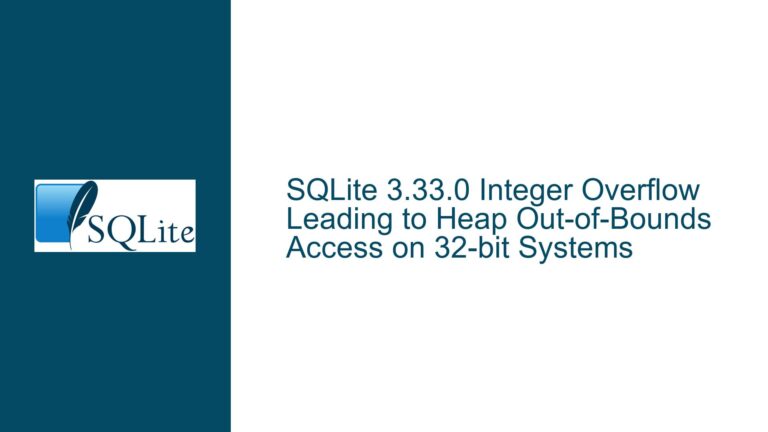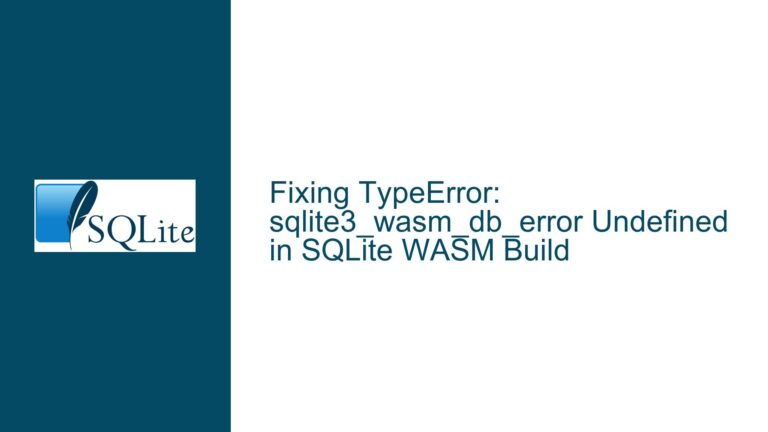SQLite CSV Export Encoding Mismatch in PowerShell Redirection
Diagnosing and Resolving UTF-8 Encoding Issues in SQLite CSV Exports via PowerShell
1. Core Problem: Mismatch Between Database Encoding and Output File Interpretation
The primary issue arises when UTF-8 encoded data stored in an SQLite database is exported to a CSV file via the SQLite command-line interface (CLI) in a PowerShell environment. While the database confirms UTF-8 encoding (via PRAGMA encoding;), the exported CSV file displays garbled characters such as "Examplé" instead of the expected "Examplé" when opened in text editors like Notepad. This occurs despite identical data appearing correctly in GUI tools like SQLite Studio. The root cause lies in how character encoding is handled during the export process, particularly when PowerShell’s output redirection operators (>) are involved.
Key observations from the discussion:
- SQLite Studio exports CSV correctly when UTF-8 is explicitly selected.
- The SQLite CLI, when invoked via PowerShell with
> $ExportPath, produces a CSV with misencoded characters. - The same CLI command produces valid UTF-8 output in Linux/WSL environments.
- Hex dumps confirm that the SQLite CLI emits valid UTF-8 bytes (e.g.,
C3 A9for "é"), but PowerShell’s redirection pipeline alters or misinterprets these bytes.
This discrepancy indicates that the problem is not with SQLite’s internal encoding but with environment-specific handling of byte streams during output redirection. PowerShell’s default behavior for text redirection introduces encoding transformations that conflict with UTF-8 byte sequences, leading to mojibake (garbled text).
2. Contributing Factors: Terminal Environments, Encoding Assumptions, and Pipeline Behavior
Three major factors contribute to this issue:
A. Terminal Emulator and System Locale Settings
PowerShell’s default encoding for redirection is influenced by the system’s active code page and locale settings. On Windows systems configured for legacy applications or non-Unicode environments:
- The system’s active code page might default to
CP-1252(Windows-1252) or another ANSI encoding. - PowerShell’s
>operator usesUTF-16LE(with BOM) by default in older versions, while newer versions (5.1+) may useUTF-8without BOM inconsistently. - The SQLite CLI detects whether its output is a terminal or a pipe/file. When output is redirected to a file, it bypasses terminal-specific encoding adjustments, emitting raw UTF-8 bytes. If the receiving environment (e.g., PowerShell) assumes a different encoding, these bytes are misinterpreted.
B. SQLite CLI’s Output Handling
The SQLite command-line interface operates differently based on output destination:
- When output is sent to a terminal, it translates UTF-8 to the console’s codepage (e.g.,
CP-437orCP-850for legacy Windows consoles). - When output is redirected to a file or pipe, SQLite emits raw UTF-8 bytes without translation. This is correct behavior for UTF-8 databases but problematic if the redirection layer applies its own encoding rules.
C. Text Editor/Viewer Misinterpretation
Notepad, by default, attempts to auto-detect a file’s encoding but often fails for UTF-8 files without a BOM (Byte Order Mark). If the CSV lacks a BOM, Notepad may fall back to the system’s ANSI encoding, misrendering UTF-8 sequences. For example:
C3 A9(UTF-8 for "é") interpreted aséin CP-1252.C3 A9misinterpreted as "├⌐" in some legacy OEM codepages.
3. Resolution Strategy: Bypassing Encoding Mismatches in Redirection Pipelines
To ensure UTF-8 integrity in CSV exports, implement the following solutions:
A. Direct File Output via SQLite’s .output Command
Avoid PowerShell’s redirection operator entirely by instructing SQLite to write directly to a file using its built-in commands:
# For SQLite versions 3.36+ (supports multiple -cmd arguments):
sqlite3.exe -cmd ".output $ExportPath" -cmd "SELECT * FROM {TableName};" -cmd ".quit" "{Database Path}"
# For older SQLite versions (pipe .quit to close the session):
echo .quit | sqlite3.exe "{Database Path}" -cmd ".output $ExportPath" -cmd "SELECT * FROM {TableName};"
This method ensures SQLite writes UTF-8 bytes directly to the file without PowerShell’s interference.
B. Enforce UTF-8 Encoding in PowerShell Redirection
Force PowerShell to use UTF-8 for redirection by:
- Using the
-Encoding UTF8parameter withOut-File:sqlite3.exe -header -csv "{Database Path}" "SELECT * FROM {TableName};" | Out-File -Encoding UTF8 $ExportPath - Changing PowerShell’s default encoding for redirection (requires PS 5.1+):
$PSDefaultParameterValues['*:Encoding'] = 'utf8' sqlite3.exe -header -csv "{Database Path}" "SELECT * FROM {TableName};" > $ExportPath
C. Validate and Normalize Encoding with Hex Editors or CLI Tools
Confirm the exported CSV’s encoding using tools like hexdump (Linux/WSL) or PowerShell’s Format-Hex:
Format-Hex -Path $ExportPath -Count 32 # Inspect first 32 bytes
Look for the UTF-8 BOM (EF BB BF) or validate UTF-8 sequences like C3 A9. If absent, re-export with explicit UTF-8 handling.
D. Use Alternative Terminal Environments
Switch to environments with consistent UTF-8 support:
- Windows Terminal + PowerShell Core (7+): Modern terminals handle UTF-8 more reliably.
- WSL (Windows Subsystem for Linux): Execute SQLite commands in a Linux shell (e.g., bash), where UTF-8 is the default.
E. Add a UTF-8 BOM for Notepad Compatibility
If downstream tools require a BOM, inject it after export:
$Utf8Bom = [System.Text.Encoding]::UTF8.GetPreamble()
$Content = Get-Content -Raw -Path $ExportPath
[System.IO.File]::WriteAllBytes($ExportPath, $Utf8Bom + [System.Text.Encoding]::UTF8.GetBytes($Content))
F. Programmatic CSV Handling with Robust Libraries
For scripted workflows, use programming languages like Python to handle CSV exports with explicit encoding:
import sqlite3
conn = sqlite3.connect('{Database Path}')
cursor = conn.cursor()
cursor.execute("SELECT * FROM {TableName};")
with open('output.csv', 'w', encoding='utf-8-sig', newline='') as f:
for row in cursor:
f.write(','.join(map(str, row)) + '\n')
By addressing the interaction between SQLite’s output behavior, PowerShell’s encoding defaults, and text viewer assumptions, users can ensure UTF-8 fidelity in CSV exports. The critical takeaway is to avoid ambiguous text pipelines and instead use direct file writes or explicitly controlled encoding transformations.






